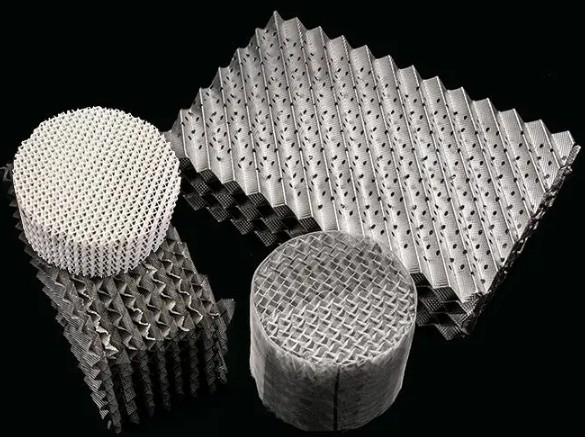Structured packing refers to specifically engineered packing materials used in various industrial processes, especially for improving mass and heat transfer efficiency in separation processes. This article aims to provide a comprehensive overview of structured packing, focusing on its types, characteristics, design, working principles, performance optimization, and applications. It will also explore its benefits, limitations, and future development trends. Understanding structured packing is crucial for improving efficiency in various industrial processes, making this material highly relevant in modern engineering.
1. What is a Structured Packing?
Structured packing is a type of column packing specifically designed and arranged into geometric patterns, offering distinct advantages over random packing. Unlike random packing, where materials are filled haphazardly, structured packing is neatly organized within the column, allowing fluids to follow complex, controlled paths. This design maximizes surface area for interaction between the liquid and gas phases without significantly impeding gas flow.
The packing is further categorized by corrugation angle into X type and Y type. X type, with a 30° angle, offers a lower pressure drop, while Y type, with a 45° angle, provides superior mass transfer capabilities. We offer various structured packing materials, including ceramic, plastic, and metal, designed to meet the specific needs of different processing environments. This design enhances mass transfer and thermal efficiency while minimizing pressure drop, making it ideal for applications such as distillation, absorption, and extraction in various industries.

2. What is the Difference Between Structured Packing and Random Packing?
2.1 Design and Arrangement
Structured Packing: Structured packing is precisely engineered and arranged in geometric patterns, typically in the form of corrugated layers or honeycomb-like discs. These layers are stacked in an orderly manner within the column, forcing fluids to follow specific, complex paths, maximizing contact area between phases.
Random Packing: Random packing, on the other hand, consists of irregularly shaped materials that are randomly dumped into the column. The packing elements do not have a fixed arrangement, leading to more chaotic fluid flow paths.
2.2 Efficiency
Structured Packing: Due to its organized structure, structured packing offers higher mass transfer efficiency and a more uniform distribution of fluids. It also results in lower pressure drop compared to random packing.
Random Packing: Random packing generally provides lower mass transfer efficiency and a less uniform fluid distribution. However, it is easier to install and typically costs less than structured packing.
3. Types of Structured Packing
3.1 Metal Structured Packing
metal structured packing, typically made from carbon steel, stainless steel (SS304, 321, 316L, 410, 904L, etc.), or other corrosion-resistant alloys, is widely used due to its high strength and excellent heat and mass transfer capabilities. It is favored in applications where high temperatures and pressures are involved, such as in distillation columns, absorption towers, and extraction processes. Metal structured packing also has many types as described below:
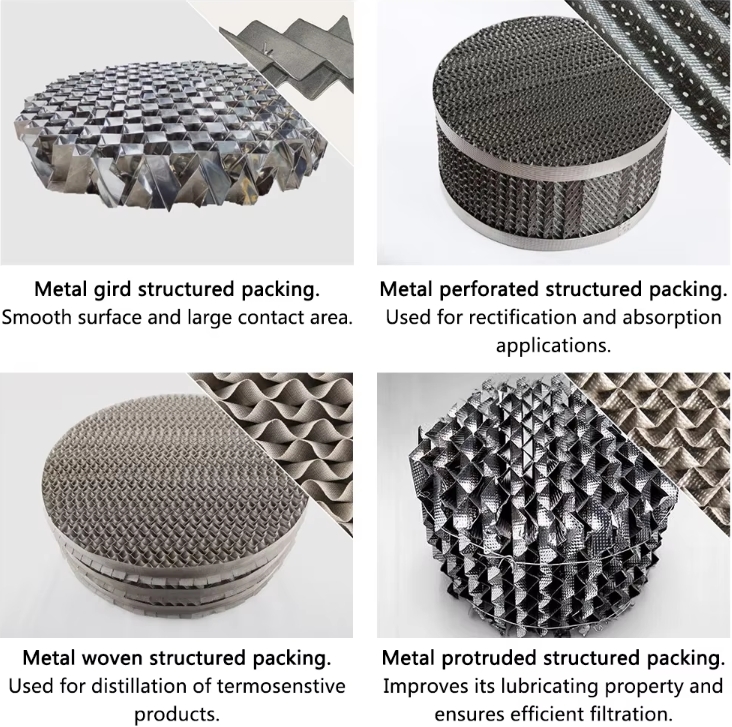
3.1.1 Wire Gauze Structured Packing
Wire gauze structured packing is a corrugated packing made from wire gauze, commonly used in fine chemical distillation where fouling is minimal. It excels in vacuum distillations with low liquid flow, optimizing mass transfer while minimizing pressure drop.
The packing's corrugated wire mesh layers are set at 45° or 60°, alternating directions to enhance separation efficiency and reduce pressure drop. This design is ideal for distilling heat-sensitive products, offering excellent performance with minimal pressure drop per theoretical stage.
3.1.2 Knitted Structured Packing
Knitted structured packing is constructed from multi-strand "cables" knitted into a high-density mesh. This mesh is crimped and can be formed into one-piece layers to fit small diameter columns or wrapped into rectangular bricks for installation through column manways. With its high surface area, the multi-strand wires enable excellent mass transfer efficiency, similar to woven gauze packing, though it typically operates at a higher pressure drop. This packing is ideal for processes such as distillation, absorption, and stripping, offering high separation efficiency and low liquid hold-up, making it suitable for systems requiring efficient mass transfer and compact design.
3.1.3 Sheet Metal Structured Packing
Sheet metal structured packing is composed of textured metal sheets assembled into bundles. Compared to wire-based materials, this type of packing is more cost-effective while still providing durability and versatility. It is capable of handling a broad range of liquid and vapor flow rates, making it suitable for various process services. Additionally, it offers better resistance to fouling, enhancing its performance in challenging conditions. Common applications include vacuum and atmospheric distillation, as well as wastewater treatment processes, where its robustness and cost-efficiency make it an attractive option for industrial use. This packing type also ensures stable operation under varying load conditions, contributing to reliable performance in diverse environments.
3.1.4 Metal Grid Structured Packing
Grid structured packing combines the surface area advantages of conventional packing with a sturdy grid construction, making it suitable for applications with high levels of fouling, corrosion, coking, and solids. This design ensures excellent heat transfer, mechanical strength, and resistance to plugging and erosion.
The packing is installed in layers, oriented at a 40° angle, which helps minimize pressure drop while boosting column performance. Its smooth surface reduces liquid hold-up, shortens residence time, and decreases the risk of coke formation. Grid packing is ideal for demanding services such as crude tower pump-around, quench towers, and flue gas scrubbers.
3.2 Plastic Structured Packing
plastic structured packing is a cost-effective option for applications where corrosion resistance is more critical than temperature resistance. Commonly used plastics include polypropylene (PP), polyvinyl chloride (PVC), and Teflon (PTFE). Plastic packing is lightweight and suitable for processes involving aggressive chemicals or low to moderate temperatures, such as water treatment or environmental protection systems.
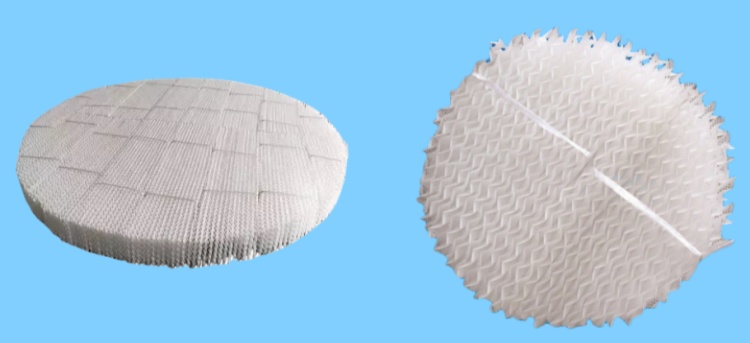
3.2.1 Plastic Gauze Structured Packing
Plastic wire mesh corrugated packing is a structured packing material used primarily in chemical and environmental engineering for separation and mass transfer processes. It consists of thin plastic wires woven into a mesh, which is then formed into corrugated sheets. These sheets are stacked together in a specific arrangement to create a large surface area within columns or reactors, enhancing the efficiency of gas-liquid contact, absorption, or distillation processes.
3.2.2 Plastic Plate Structured Packing
Plastic plate structured packing is typically made from materials such as polypropylene (PP) and polyethylene (PE), with plate packing options available in PP or PVDF. To enhance mass transfer efficiency, openings can be incorporated into the plates. Additionally, plastic wire gauze packing, also made from PP or PE, is available for specific applications.
Similar to ceramic and metal structured packing, plastic structured packing can be manufactured in both round and rectangular configurations. Custom shapes can also be designed to meet specific process requirements, making it a versatile solution for various separation and mass transfer processes.
3.3 Ceramic Structured Packing
ceramic structured packing is a column-shaped, single-layer corrugated packing made up of multiple pieces with identical geometric shapes arranged parallel to one another. Based on the angle of the corrugated sheets, the packing is classified into two types: X-style and Y-style. The X-style corresponds to a 30° inclination, while the Y-style has a 45° inclination. This design allows for improved mass transfer efficiency and low pressure drop in various industrial applications.
4. Basic Characteristics of Structured Packing
4.1 Surface Area and Void Fraction
Structured packing is designed to provide a large surface area for gas-liquid interaction while maintaining a high void fraction, which minimizes resistance to flow. This balance ensures efficient mass and heat transfer with a relatively low pressure drop, a significant advantage over random packing.
4.2 Gas-Liquid Contact Efficiency
The geometric arrangement of structured packing ensures uniform gas and liquid distribution, improving the overall contact efficiency between the two phases. This is crucial for separation processes like distillation, where increased contact enhances the effectiveness of mass transfer.
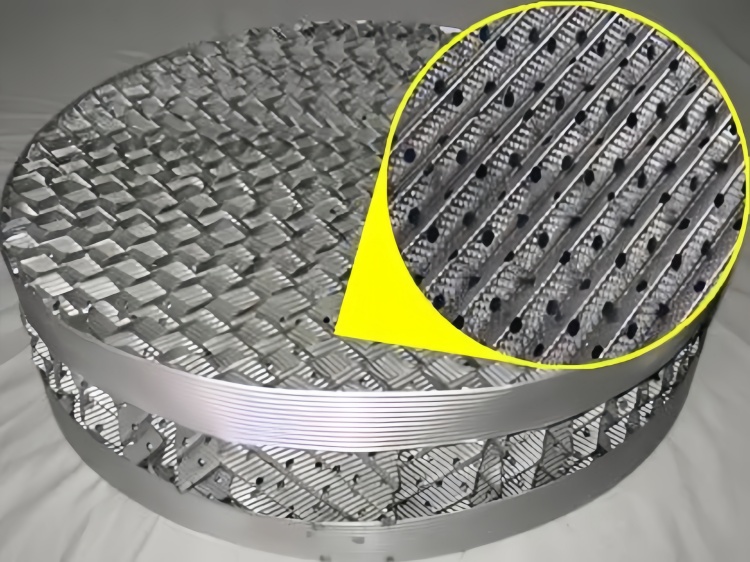
4.3 Pressure Drop in Structured Packing
One of the key benefits of structured packing is its low-pressure drop compared to other packing types. The ordered structure promotes smooth fluid flow, reducing the energy required for gas movement through the packing. This makes it ideal for processes where pressure drop is a critical factor.
4.4 Heat and Mass Transfer Efficiency
Structured packing exhibits high heat and mass transfer efficiencies due to its regular structure, which increases the contact area and improves the interaction between the gas and liquid phases. These characteristics make it a preferred choice for energy-efficient processes, such as distillation and absorption.
5. How Does Structured Packing Work?
5.1 Gas-Liquid Contact Mechanism
Structured packing enhances gas-liquid interaction by providing a large surface area for mass transfer. As gas flows upward and liquid flows downward through the packing, the phases are forced into close contact, enabling efficient exchange of heat and mass.
5.2 Mass Transfer Mechanism in Structured Packing
The corrugated or saddle-shaped geometry of structured packing facilitates better phase distribution and increased surface area for mass transfer. This improves the efficiency of separation processes such as distillation, absorption, and extraction.
5.3 Gas Flow and Liquid Distribution
The uniform structure of the packing ensures an even distribution of liquid over the packing surface, minimizing channeling and dry spots that can reduce separation efficiency. Proper liquid distribution is key to maximizing mass transfer in the system.
5.4 Efficiency in Absorption and Separation Processes
Structured packing is highly effective in processes that require precise control of gas-liquid interactions, such as the absorption of gases in liquids or the separation of chemical components in distillation. The efficiency of these processes is enhanced by the large surface area and uniform phase distribution provided by structured packing.
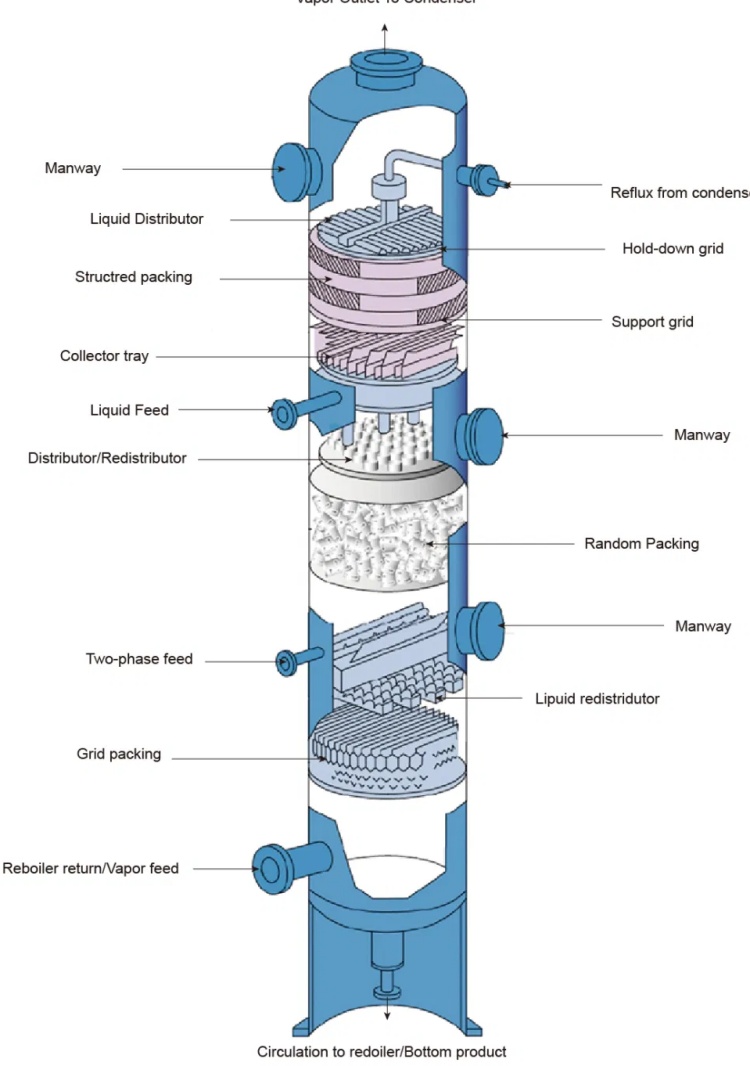
6. Performance Optimization of Structured Packing
6.1 Effect of Operating Conditions
6.1.1 Gas-Liquid Ratio Optimization
The ratio of gas to liquid flow rates is a critical factor in determining the efficiency of mass transfer in structured packing systems. Operating at the optimal gas-liquid ratio maximizes the contact area and improves the separation efficiency.
6.1.2 Impact of Temperature and Pressure on Mass Transfer
Temperature and pressure conditions directly influence the mass transfer characteristics in structured packing. Understanding how these variables affect phase interactions is essential for optimizing the performance of the packing in specific applications.
6.2 Effect of Packing Installation on Performance
6.2.1 Vertical Installation
Vertical installation of structured packing is the most common method, promoting uniform gas and liquid distribution. It is ideal for tall distillation or absorption columns where maximizing efficiency is critical.
6.2.2 Angled Installation
Angled installation can enhance liquid spreading and reduce the risk of channeling in certain applications. This method may be used in specialized situations where standard vertical packing is less effective.
6.3 Optimization of Equipment Size and Configuration
Structured packing allows for flexibility in equipment design, enabling operators to tailor column height, diameter, and packing density to suit specific operational needs. This optimization improves the overall performance of the separation process while reducing energy consumption.
7.Application of Structured Packing in Various Industries
Structured packing is a highly engineered and versatile component used in many industrial processes. Known for its ordered, uniform arrangement, structured packing provides efficient mass and heat transfer between gas and liquid phases. The design typically involves a series of crimped or corrugated sheets, often made from materials like metal, plastic, or ceramic. In this article, we explore the key applications of structured packing across different industries, highlighting its benefits and efficiency.
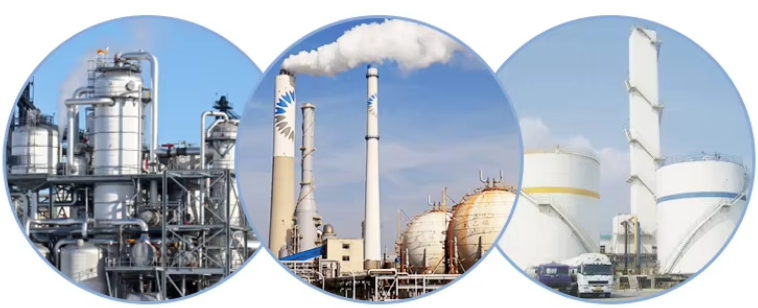
7.1 Distillation Columns
One of the most common applications of structured packing is in distillation columns, where the separation of chemical mixtures based on volatility differences is required. Structured packing enhances the surface area for vapor-liquid contact, improving separation efficiency while minimizing pressure drop. This is particularly valuable in industries such as petrochemicals and oil refining, where high throughput and energy efficiency are paramount.
For example, structured packing in distillation columns is favored for processing fine chemicals and in processes that require high separation efficiency, such as separating close-boiling components or handling temperature-sensitive materials.
7.2 Absorption Towers
Absorption processes involve the transfer of a specific gas component into a liquid solvent. Structured packing is commonly used in absorption towers due to its high mass transfer efficiency. It increases the contact area between the gas and liquid phases, allowing for more effective absorption with lower pressure drops. This application is widely seen in gas treatment plants, including carbon dioxide capture and removal of impurities in natural gas processing.
7.3 Stripping Towers
Stripping is the opposite of absorption, where a gas is used to strip or remove a volatile component from a liquid stream. Structured packing ensures efficient stripping by providing a large surface area for mass transfer, which is crucial in industries such as wastewater treatment, solvent recovery, and in some processes of the oil and gas industry.
7.4 Chemical Reaction Columns
Structured packing plays a significant role in catalytic reaction columns, such as in reactive distillation, where both reaction and separation processes occur simultaneously. The high surface area and uniform gas-liquid distribution provided by structured packing enhance the efficiency of these complex processes. This makes structured packing ideal for industries such as fine chemicals, pharmaceuticals, and agrochemicals, where high purity and precise control over reactions are essential.
7.5 Heat Exchange Applications
Structured packing is also used in heat exchangers where direct contact between the gas and liquid phases facilitates efficient heat transfer. By using structured packing, companies can achieve better temperature control and energy savings in processes like air stripping and solvent cooling. Heat exchange systems using structured packing are especially beneficial in chemical processing and environmental engineering applications.
7.6 Bioethanol Production
Structured packing has also found applications in the bioethanol industry, particularly in the distillation and dehydration stages. Its ability to handle high vapor rates and provide efficient separation makes it ideal for producing high-purity ethanol, an essential component in the fuel and beverage industries.
8. Advantages and Limitations of Structured Packing
8.1 Advantages of Structured Packing
8.1.1 High Mass Transfer Efficiency
Structured packing offers significantly higher mass transfer efficiency compared to random packing. Its ordered structure and large surface area provide more opportunities for gas and liquid phases to interact, improving separation processes such as distillation, absorption, and extraction.
8.1.2 Low Pressure Drop
The low-pressure drop across structured packing reduces the energy required to drive gas through the column, making the process more energy-efficient. This advantage is especially important in processes where energy consumption must be minimized, such as in large-scale distillation or environmental systems.
8.1.3 Compact Design and Space Efficiency
Due to its highly organized structure, structured packing can achieve higher separation efficiencies in a smaller volume compared to random packing or tray-based systems. This results in more compact equipment designs, which is beneficial for applications where space is limited.
8.2 Limitations of Structured Packing
8.2.1 High Sensitivity to Liquid Distribution
Structured packing relies on uniform liquid distribution to achieve optimal performance. Poor liquid distribution can lead to inefficiencies, such as channeling or dry spots, which reduce mass transfer efficiency. This sensitivity requires careful design of liquid distributors and proper installation to ensure consistent performance.
8.2.2 Higher Initial Investment Costs
The manufacturing process for structured packing is more complex and costly than for random packing. The precise engineering required to produce the regular geometric structure increases the initial investment costs, though these costs are often offset by the long-term operational savings from increased efficiency.
8.2.3 Risk of Fouling and Blockage
In certain processes, especially those involving viscous or particulate-laden fluids, structured packing can be prone to fouling or blockage. This occurs when solids or viscous materials build up on the packing surface, reducing the available surface area for mass transfer and increasing pressure drop.
Conclusion
Structured packing plays a vital role in enhancing the efficiency of mass and heat transfer processes across a wide range of industries. From chemical processing to environmental protection, the versatility and performance advantages of structured packing make it a valuable asset in modern engineering.777
For more information on structured packing, its advantages, and guidance on selecting the ideal packing material for your needs, we're ready to assist. Our company provide high-quality internals, including various structured packing solutions, along with consultants to support you from design through to supply.
